A recent sharing day at Kihikihi Kindergarten affirmed their commitment to the Enviroschools kaupapa and the depth and breadth of the Guiding Principles within their teaching and learning environment. Find out more about what a Green-Gold kindergarten looks and feels like.
Learning is lived
Each of us brings unique perspectives and gifts, and it is by uniting them that sustainable communities will be created. – Enviroschools Handbook
Juicy sweet strawberries, crisp green herbs and vegetables, twining kūmara vines. Tamariki at Kihikihi Kindergarten actively contribute to the mahi and decisions made in their māra kai and reap the rewards of yummy fruit and vegetables. There is a real sense of ownership and responsibility through opportunities to work with nature and allow nature to teach. Guided by the maramataka they plant, nurture and harvest from their māra kai to then prepare and share the produce.
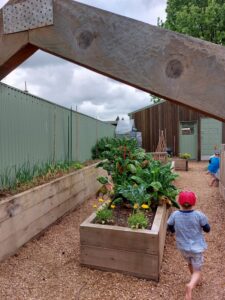
Growing nutritious food is part of life at Kihikihi Kindergarten.
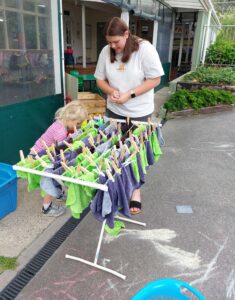
Washing and drying the hand towels is part of the daily routines at Kihikihi.
Integrating daily practices
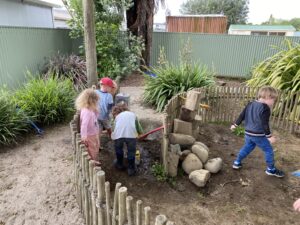
Mud magic.
Kihikihi Kindergarten has created a healthy and stimulating environment through thoughtful planning and implementation to reflect their vision of sustainability. This includes a mix of restful places, action places and places where sustainability is in practice. Kaitiakitanga is evident through the way tamariki care for and respect their place. Tamariki take responsibility for waste systems including sorting kai scraps and soft plastics.
About 3 years ago the Kindergarten decided to reduce their waste created from paper towels by buying cloth towels to reuse. After research they decided on Mum 2 Mum cloths. These original cloths are still in good condition, having lasted well. Washing and drying the cloths is one of the many practices at the Kindergarten the tamariki take a role in. It is also providing financial saving now the kindergarten doesn’t have to purchase paper towels.
Connected community

Showing the worm bin action – so many worms and slaters and a slug!
A long-standing connection with renowned author Sharon Holt and the kindergarten has resulted in a fun book promoting the commitment to Zero Waste. ’Taihoa e hoa’ book came about through a conversation between Kaiako, Sue, and Sharon. The Holt children (now adults) went to Kihikihi Kindergarten and Sharon once taught there. They have maintained a connection and, as Sharon’s “last” sing-along book project, she involved the tamariki at the kindergarten to capture the images that help share the Zero Waste message. This book and its message to wait, my friend and think again, is now integral to the learning at Kihikihi, in particular empowering tamariki to question resource use and repurpose objects.
Mum, Megan, mentioned how her daughter actively collected scraps and notions from home so that these could be used in her artwork, easily able to talk about the reasons behind this.
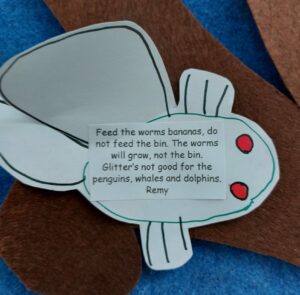
Tamariki have an understanding of the consequences of their behaviour and that of others.
Matua X from Xtreme Zero Waste is another local and has helped bring fun into a serious issue and helped implement simple solutions. Just up the road is the base of the local Māori Women’s Welfare League and community gardens. There are multiple opportunities identified to support and learn from each other. One aspect of this was the making and gifting to the kindergarten of some much-cherished korowai. These are just 3 of the examples of how local people support the depth and breadth of learning and action within the Kihikihi Kindergarten community.
A sense of place and belonging
Nurturing an understanding and love for where they live is part of the kaupapa of Kihikihi Kindergarten. Pūrākau about the battle of the maunga surrounding Kihikihi are evident in the play environment and retold using creatively painted stones, on paper or building in the sandpit. They also talk about the significance of the fertile land and the history of food cultivation and trade. There is now a developing recognition and wonder of this rohe and an awareness of where they live and where their kindergarten friends live.
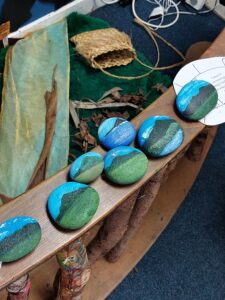
These beautifully painted stones are used to retell the pūrākau of the area.
You are so driven and focused on providing a wide variety of opportunities for tamariki as they engage in practical experiences that will foster greater understanding of sustainable education. Your acknowledgement of the four maunga surrounding the Kindergarten, the local pūrākau and the recognition of the stories yet to be understood were a highlight for me. This will provide such a rich curriculum base for the children and kaiako at Kihikihi. – Rosemary Searle, Enviroschools Facilitator
Kihikihi tamariki, kaiako, and whānau have some clear ideas about what they will explore next. One aspect that they would like to explore is pepeha. They would also like to continue strengthening their relationships with the Māori Women’s Welfare League and local experts at the community gardens. A peach tree that honours the food growing history will be planted in celebration of the Enviroschools Green-Gold milestone.
I wanted to reiterate what an incredible environment you provide for the tamariki and whānau – the way you weave through the Enviroschools Kaupapa into your practices and programme is so instinctive, embedded and inspiring. We feel very fortunate to have Kihikihi as part of the Enviroschools network. – Katie Higgins, Enviroschools National Team

The Kihikihi teaming team proudly acknowledge their Green-Gold journey.
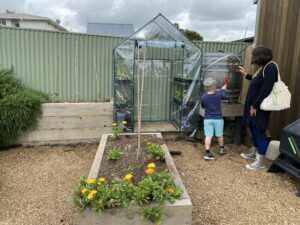
Rochelle gets an explanation of the water collection system.
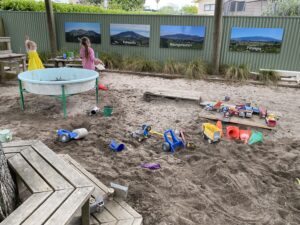
The mountains that surround Kihikihi are part of their place, their landscape and their identity at Kihikihi.
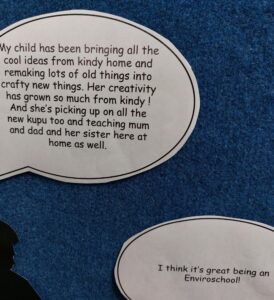
Whānau feedback!
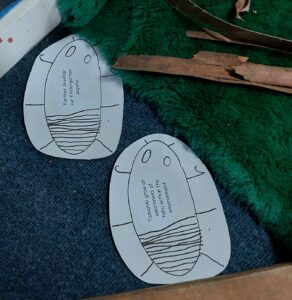
Some next steps were identified to broaden learning opportunities.
You can also read about this commitment to the Enviroschools kaupapa at Kihikihi Kindergarten by reading the Te Awamutu Courier article here.